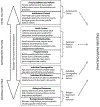Applying a Health Equity Lens to Urinary Incontinence
- PMID: 33859095
- PMCID: PMC8552501
- DOI: 10.1097/GRF.0000000000000613
Applying a Health Equity Lens to Urinary Incontinence
Abstract
Health equity is attained when everyone has the opportunity achieve the health they envision; however, health disparities are a barrier to health equity. As health disparities specific to urogynecology exist, it is critical to examine and contextualize them in a framework that improves understanding of what factors may drive these disparities to craft effective solutions. This article will review what we currently know about urinary incontinence disparities and provide a framework for evaluation as well as a framework for advancing health equity in the care of diverse patient populations with urinary incontinence.
Copyright © 2021 Wolters Kluwer Health, Inc. All rights reserved.
Figures
References
-
- The World Health Organization. Social determinants of Health. https://www.who.int/health-topics/social-determinants-of-health#tab=tab_1. Accessed December 1, 2020.
-
- LaVeist TA GD, Richard P. Estimating the economic burden of racial health inequalities in the United States. Int J Health Serv. 2011;41(2):231–238. - PubMed
-
- Brown O, Siddique M, Mou T, Boniface ER, Volpe KA, Cichowski S. Disparity of Racial/Ethnic Representation in Publications Contributing to Overactive Bladder Diagnosis and Treatment Guidelines. Female pelvic medicine & reconstructive surgery. 2020;Publish Ahead of Print. - PubMed
-
- HealthyPeople.gov. Disparities. http://www.healthypeople.gov/2020/about/disparitiesAbout.aspx. Accessed Dcemeber 1, 2020.
Publication types
MeSH terms
Grants and funding
LinkOut - more resources
Full Text Sources
Other Literature Sources
Medical
Research Materials


